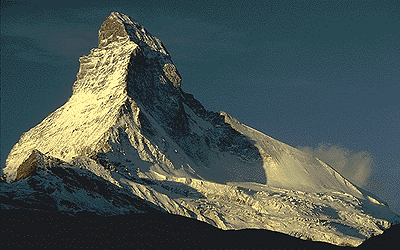An Introduction to Structural Geology and Tectonics
|
An Introduction to Structural Geology and Tectonics |
 Did
you ever take a cross-country drive? Hour after hour of tedious driving,
as the highway climbed hills and then dropped into valleys? The monotonous
gray rocks exposed in road cuts probably went unnoticed, right? You passed
pretty scenery, but it was static and seemed to tell no story simply because
you did not have a basis in your mind with which to interpret your surroundings.
Did
you ever take a cross-country drive? Hour after hour of tedious driving,
as the highway climbed hills and then dropped into valleys? The monotonous
gray rocks exposed in road cuts probably went unnoticed, right? You passed
pretty scenery, but it was static and seemed to tell no story simply because
you did not have a basis in your mind with which to interpret your surroundings.
It was much the same for scholars of generations past, before the establishment of modern science. The Earth was a closed book, hiding its secrets in a language that no one could translate. Certainly, ancient observers marveled at the enormity of mountains and oceans, but with the knowledge they had at hand they could do little more than dream of supernatural processes to explain the origin of these features. Gods and monsters contorted the Earth and spit flaming rock, and giant turtles and catfish shook the ground. Then, in 15th century Europe, an intellectual renaissance spawned an age of discovery, during which the Earth was systematically charted and the pioneers of science cast aside a dogmatic view of the universe that had closed people's minds for the previous millennia and began to systematically observe their surroundings and carry out experiments to create new knowledge. The scientific method was born.
In geology, the stirrings of discovery are evident in the ink sketches of the great 15th and early 16th century artist and scientist Leonardo da Vinci, who carefully drew the true shapes of rock bodies in sketches to understand the natural shape of the Earth. In the 17th century came the first description of rock deformation. Nicholas Steno examined outcrops where the bedding of rock was not horizontal, and speculated that strata that do not presently lie in horizontal layers must have in some way been "dislocated" (the term he used for deformed). Perhaps Steno's establishment of the principle of original horizontality can be viewed as the birth of structural geology. By the beginning of the 18th century, the structural complexity of rocks in mountain ranges was widely recognized, as is evident in the Alpine sketches of the German artist Johannes Scheuchzer published in 1716, and it became clear that such features demanded explanation.
The pace of discovery quickened during the latter half of the 18th century and through the 19th century. Ever since the publication of James Hutton's "Theory of the Earth with Proofs and Illustrations" in 1785, the book in which the concept of uniformitarianism and the nature of unconformities were proposed, there has been a group of scientists who recognized themselves as geologists. These new geologists defined the geometry of structures in mountain ranges, learned how to make geologic maps, discovered the processes involved in the formation of rocks, and speculated on the origins of specific structures and on mountain ranges in general.
Ideas about the origin of mountains have evolved gradually. At first, mountain ranges were thought to be a consequence of a vertical push from below, perhaps associated with intrusion of molten rock along preexisting zones of weakness, and folds and faults in strata were attributed to gravity sliding down the flanks of these uplifts. Subsequently, the significance of horizontal forces was emphasized and geologists speculated that mountain ranges and their component structures reflected the contraction of the Earth that resulted from progressive cooling. In this model, the shrinking of the Earth led to wrinkling of the surface. One of the more notable discoveries of this period was James Hall's recognition that Paleozoic strata in the Appalachian Mountains of North America were much thicker than correlative strata in the interior of the continent. This discovery led to the development of geosyncline theory, a model in which deep subsiding sedimentary basins called geosynclines evolved into mountain ranges. Contraction theory and geosynclinal theory, or various combinations of the two, were widely accepted until the formulation of plate tectonic theory in the 1960's.
As the foundations of geology grew, diverse features of rocks and mountains gained names, and the once amorphous, nondescript masses of rock exposed on our planet became history books telling the Earth's biography. Perhaps your concept of the planet has evolved rapidly as well, because of the courses in geology that you have taken thus far. Now, as you drive cross country, you scare the daylights out of your passengers as you twist to see roadside outcrops. "Wow! Look at that fault.....did you see that dike.....and that fold!" The outcrops are no longer gray masses to you, but they contain patterns and shapes and fabrics. The purpose of this book is to increase your ability to interpret these features and to use them as clues to understanding the processes that have shaped and continue to change the outer layers of the Earth.